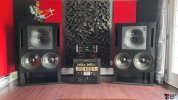This must be a thread for blind people because I can't see where you're going.
Though, I do have a fascination with Dwarfs.
Likewise, I never miss an episode of LPBW
The pursuit of lower levels of noise and distortion and probably frequency response accuracy will have little effect on an increased realism of music reproduction compared to listening at a live level volume and vast amounts of dynamic range. Lowering levels of noise and distortion address only the perception of what sounds pleasing (the hoax) and not what sounds real.
With most of us listening to music at compressed, background level (<80db average) volumes the sounds heard probably benefit somehow from differing types and levels of noise and distortion, being a psychoacoustic event rather than reality it's difficult to say what is going on. At least up to the point where it ceases to become a distraction. Just speculating based on the worst measuring components and many user's still favorable opinions of what they hear that would be -40db for distortion and -75db for noise. Yes, I say measurements better than this offer no audible benefit.
The very essence of live music is the loudness and dynamc range, something seldom achievable in a residential setting with typical loudspeakers if at all. Then again it's quite possible that most audiophiles don't want an everyday +100db emotional experience considering the effort involved.
Phoney, euphonic sound is easy to get along with and, fortunately for everyone involved, ripe for subjective opinion about the merits or failings of it.
This is not a hit piece, this question is addressed at the 1% of audiophiles who are serious about what they do not the deluded hangers-on who just bought a Topping DAC or industry reps on an agenda with flippant remarks aiming to discount what I consider to be one of the simplest questions anyone could ask about the subject.
BTW, I am not part of the 1% and I don't listen at more than 80db.


